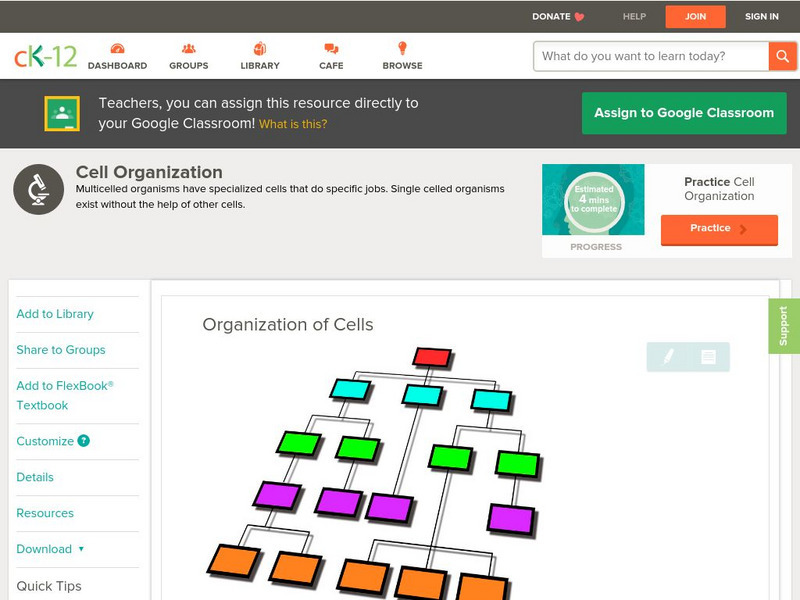Hi, what do you want to do?
Curated OER
The Physiological Tolerance of Two Species of Protozoans
High schoolers examine the differences in pH tolerance between the two species and relate these differences to their respective niches.
Curated OER
Tissue Types
In this human tissue instructional activity, students read about the 4 different tissue types in the body. Students read 4 pages about the types.
Curated OER
Genetic Changes
In this genetic change activity, students will explore the changes that can occur in DNA including point mutations and chromosomal mutations. This activity has 11 multiple choice questions.
Curated OER
What a Waste!
Fourth graders explore the kidney, bladder, and function of the excretory (urinary) system.
Curated OER
What is an Animal?
In this animal instructional activity, students review various characteristics that are associated with animals including body plan and skeletal structure. This instructional activity has 11 fill in the blank questions.
Curated OER
Genetics: Knowledge Quiz
In this genetics quiz activity, students complete a set of 10 multiple choice questions covering various concepts of genetics. A reference web site is given for additional resources.
Curated OER
Knowledge Quiz: Bacteria
In this bacteria quiz worksheet, students complete a set of 10 multiple choice questions covering a variety of concepts related to bacteria. A reference web site is included for additional resources.
Curated OER
The Skeleton Within
Fourth graders explore the bones, joints, and other attributes of the skeletal system.
Curated OER
You Have Nerve!
Fourth graders investigate the nervous system and how it communicates messages to and from the brain.
Curated OER
Systems Working Together
Fourth graders practice reading in the content areas (science) in order to explore the interdependence of the body systems. They answer written questions after reading.
Curated OER
Genes
Students explore the history, inheritance and mutations of genetics. In this genetic lesson students complete experiments on DNA sequences.
Curated OER
Your Amazing Brain
In these reading comprehension worksheets, 8th graders read a passage about the brain. Students then answer 5 reading comprehension questions about the text.
Curated OER
Homonyms- Quiz 28
Students examine the use of homonyms in sentences. Learners read a sentence online and choose the correct homonym from the answer choices. Students click on the answer box to see the correct answer.
Curated OER
Here's Looking at You
Students assess some common inherited traits which are easily observable and note their phenotype for the trait. Students compare their phenotypes to those of their parents and attempt to describe the pattern and manor of inheritance.
Curated OER
Algae
In this biology worksheet, students identify and locate various vocabulary terms pertaining to algae. There are 54 biology terms located in the word search.
University of South Florida
Project Oceanography: Single Celled Organisms [Pdf]
In this lesson, students explore three kinds of symbiotic relationships involving unicellular organisms. They will also look more closely at the relationship between zooxanthellae and coral, and the importance of nitrogen-fixing bacteria...
TED Talks
Ted: Ted Ed: What Is the Biggest Single Celled Organism?
The elephant is a creature of epic proportions- and yet, it owes its enormity to more than 1,000 trillion microscopic cells. And on the epically small end of things, there are likely millions of unicellular species, yet there are very...
TED Talks
Ted: Ted Ed: How a Single Celled Organism Almost Wiped Out Life on Earth
Anusuya Willis explains how cyanobacteria, simple organisms that don't even have nuclei or any other organelles, wrote a pivotal chapter in the story of life on Earth. [4:14]
Howard Hughes Medical Institute
Hhmi: Biointeractive: The Eukaryotic Cell Cycle and Cancer
Cell division is the only way single-celled organisms can reproduce. Learn more about cell division and explore the phases, checkpoints, and protein regulators of the cell cycle in this interactive. Find out how mutated versions of these...
TeachEngineering
Teach Engineering: Cell Celebration!
Students look at the components of cells and their functions. The lesson focuses on the difference between prokaryotic and eukaryotic cells. Each part of the cell performs a specific function that is vital for the cell's survival....
CK-12 Foundation
Ck 12: Biology: Organization of Cells
[Free Registration/Login may be required to access all resource tools.] Learn how multicelled organisms have specialized cells that do specific jobs and single celled organisms exist without the help of other cells.
National Geographic
National Geographic: Blog: Tiny Critter Has Seven Sexes
Meet the freshwater Tetrahymena, a single-celled creature that has seven possible sexes. This article presents information from recent research that helps explain how the creature reproduces and how its sex is determined.
Bio Topics
Bio Topics: Bacterial Cell Structure
An information page about the structure of the single-celled organism, bacteria. Learn about their major parts and size.





















![Project Oceanography: Single Celled Organisms [Pdf] Lesson Plan Project Oceanography: Single Celled Organisms [Pdf] Lesson Plan](https://static.lp.lexp.cloud/images/attachment_defaults/resource/large/FPO-knovation.png)






